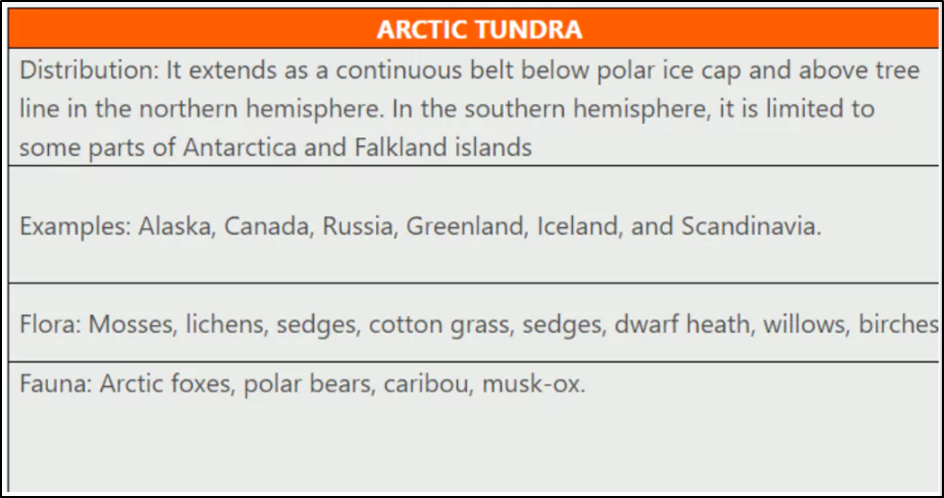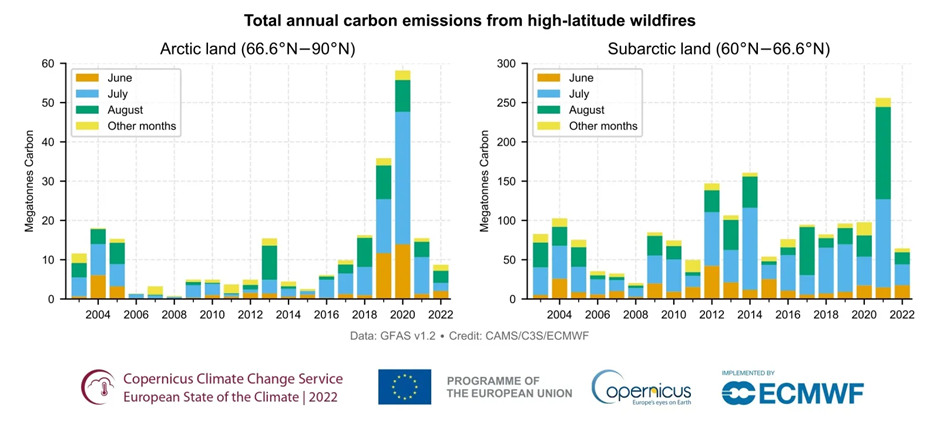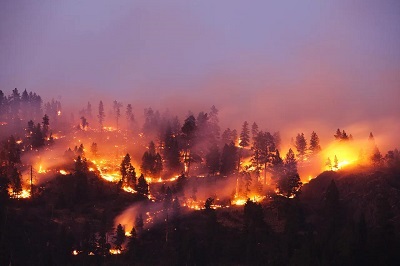Context:
Europe’s Copernicus Climate Change Service (C3S) said that high intensity fires have erupted a third time in the past five years in the Arctic region.
The Growing Frequency and Scale of Arctic Wildfires
Wildfires have traditionally been a natural part of the Arctic’s boreal forest and tundra ecosystems. However, in recent years, their frequency and scale have dramatically increased. Europe’s Copernicus Climate Change Service (C3S) reported that in the past five years, high-intensity fires have erupted in the Arctic thrice.
In Sakha, Russia, more than 160 wildfires charred nearly 460,000 hectares of land by June 24, according to Russia's state news agency Tass. The June monthly total carbon emissions from these wildfires reached 6.8 megatonnes of carbon, the third highest in the past two decades, behind June 2020 and 2019.

The Impact of Global Warming on Arctic Wildfires
- Increasing Global Temperature
The Arctic has been warming roughly four times faster than the rest of the world. While the global average temperature has increased by at least 1.1 degrees Celsius above pre-industrial levels, the Arctic has warmed by around 3 degrees since 1980. This rapid warming has led to more frequent lightning, which in turn increases the likelihood of wildfires.
Lightning-sparked fires have more than doubled in Alaska and the Northwest Territories since 1975. Soaring temperatures have also slowed down the polar jet stream, leading to unseasonably warm weather and heatwaves in the region, further exacerbating the wildfire situation.
- The Role of Rising Temperatures, Lightning, and Heatwaves
- Three main factors contribute to the worsening Arctic wildfires:
- Rising temperatures,
- More frequent lightning
- Heatwaves.
- Rising temperatures,
- By 2050, it is estimated that wildfires in the Arctic and globally could increase by one-third, according to a World Wild Fund report. Thunderstorms, driven by warm moist updrafts, are more likely to occur over ice-free land, leading to increased lightning activity. Additionally, the polar jet stream often gets “stuck,” blocking out low-pressure systems that bring clouds and rainfall, which can lead to intense heat waves and more wildfires.
- Three main factors contribute to the worsening Arctic wildfires:
The Global Consequences of Arctic Wildfires
- Rising Greenhouse Gases: Arctic wildfires contribute to climate change by releasing greenhouse gases (GHGs) such as carbon dioxide (CO2) into the atmosphere. However, the greater concern is the carbon stored underneath the region’s permafrost.
- Thawing Permafrost: Arctic permafrost holds around 1,700 billion metric tons of carbon, including methane and CO2. Wildfires make permafrost more vulnerable to thawing by destroying upper insulating layers of vegetation and soil, causing ancient organic materials to decompose and release carbon.
- Carbon Release: Large-scale thawing of Arctic permafrost could result in an unstoppable release of carbon, making it impossible to limit global warming within the 1.5-degree Celsius threshold.

Addressing Arctic Wildfires
- Monitoring and Understanding Wildfires: Focus on conserving and sustainably using Arctic flora and fauna by mapping annual acreage burned, and incorporating relevant fire ecology and Indigenous Knowledge research. Evaluate the impacts of wildfires on Arctic ecosystems, air quality, and climate change.
- International cooperation on Wildfire: International cooperation is crucial for effective wildfire response to:
- Improve coordinated response among Arctic States and Permanent Participants to catastrophic wildland fires.
- Promote international cooperation and the possibility of contracting wildland fire resources across state boundaries.
- Coordinate training between relevant agencies to ensure effective and contemporary emergency prevention, preparedness, and response to wildland fires.
- Improve coordinated response among Arctic States and Permanent Participants to catastrophic wildland fires.
- Applying Indigenous and Local Knowledge: Arctic communities, having lived with fire for millennia, are sharing their expertise to aid in the understanding, response, and adaptation to wildfires. The Gwich’in Council International leads much of the Arctic Council’s work in this area, emphasising the importance of Indigenous and local knowledge in addressing wildland fires.
The Urgency for Global Action
The consequences of Arctic wildfires extend beyond the region, amplifying global risks. Scientists at the Copernicus Atmosphere Monitoring Service, emphasised the need for urgent action, stating, “What happens in the Arctic doesn’t stay there — Arctic change amplifies risks globally for all of us. These fires are a warning cry for urgent action.”
Currently, there is no monitoring of post-fire permafrost emissions, and they are not included in climate models, making it difficult to estimate their contribution to climate change. Rising Arctic wildfires pose a significant threat to the global climate. Immediate and concerted efforts are required to address this growing crisis and mitigate its far-reaching impacts.
|
Probable Questions for UPSC Mains Exam-
|
Source: Indian Express







